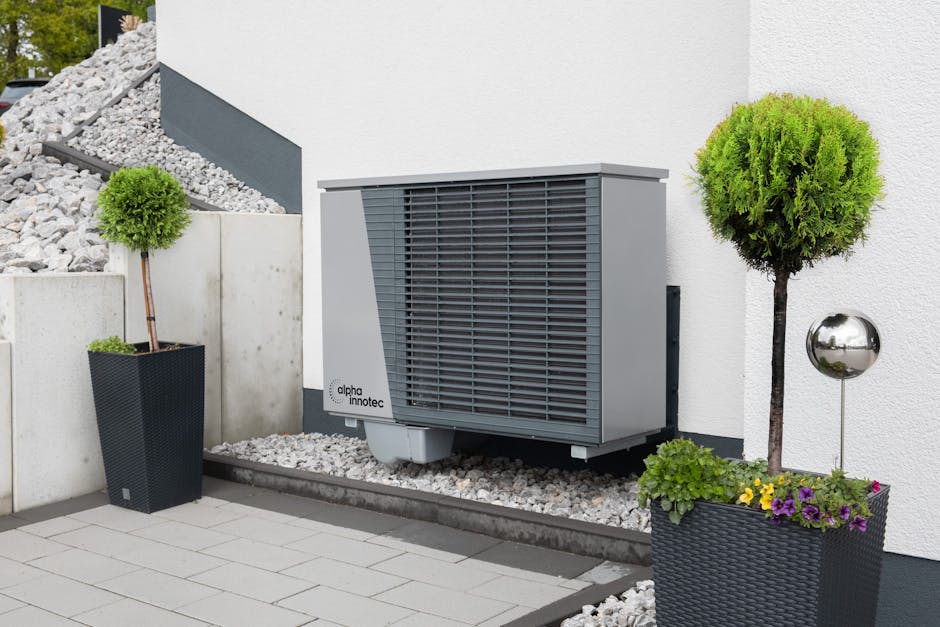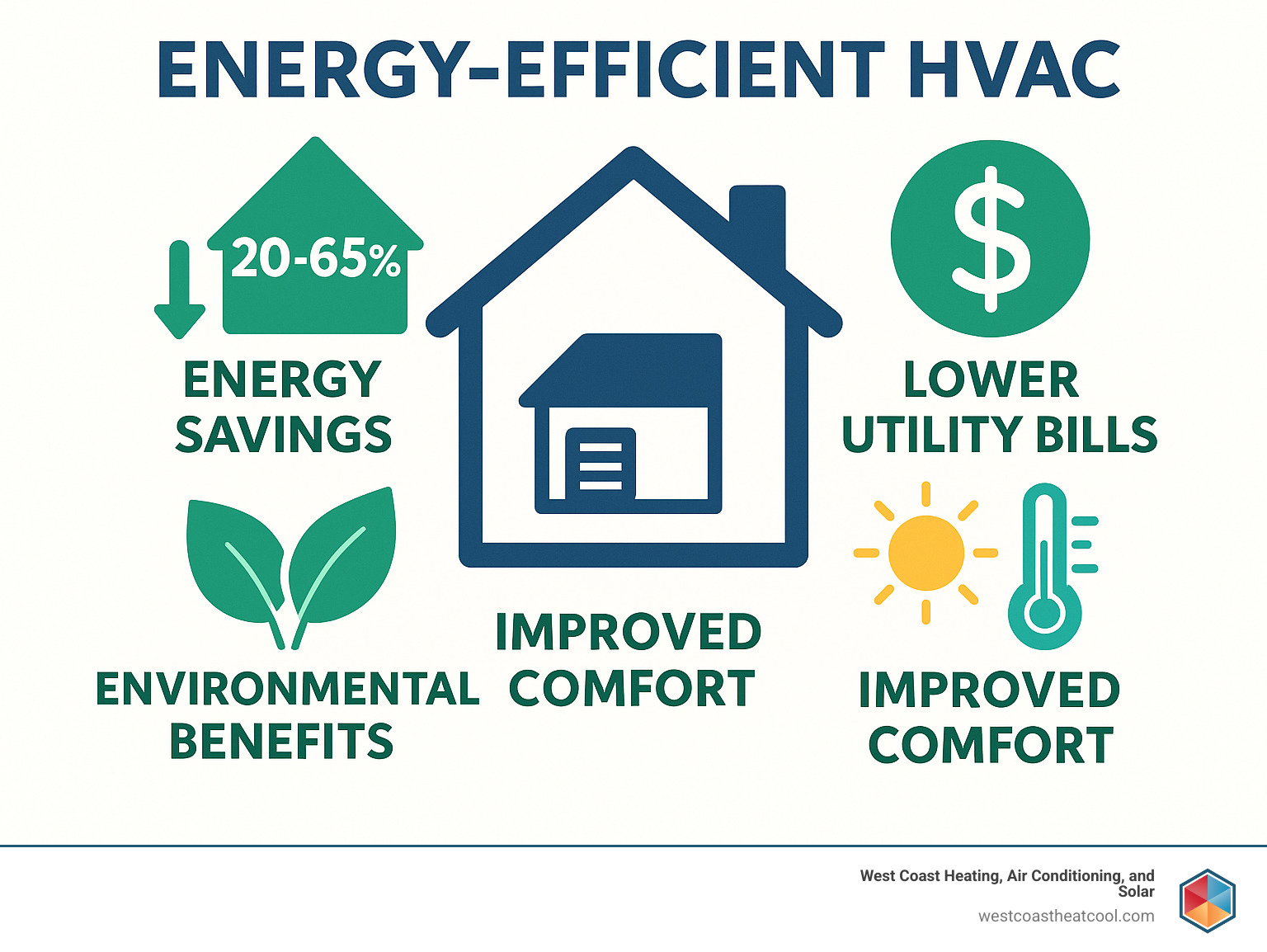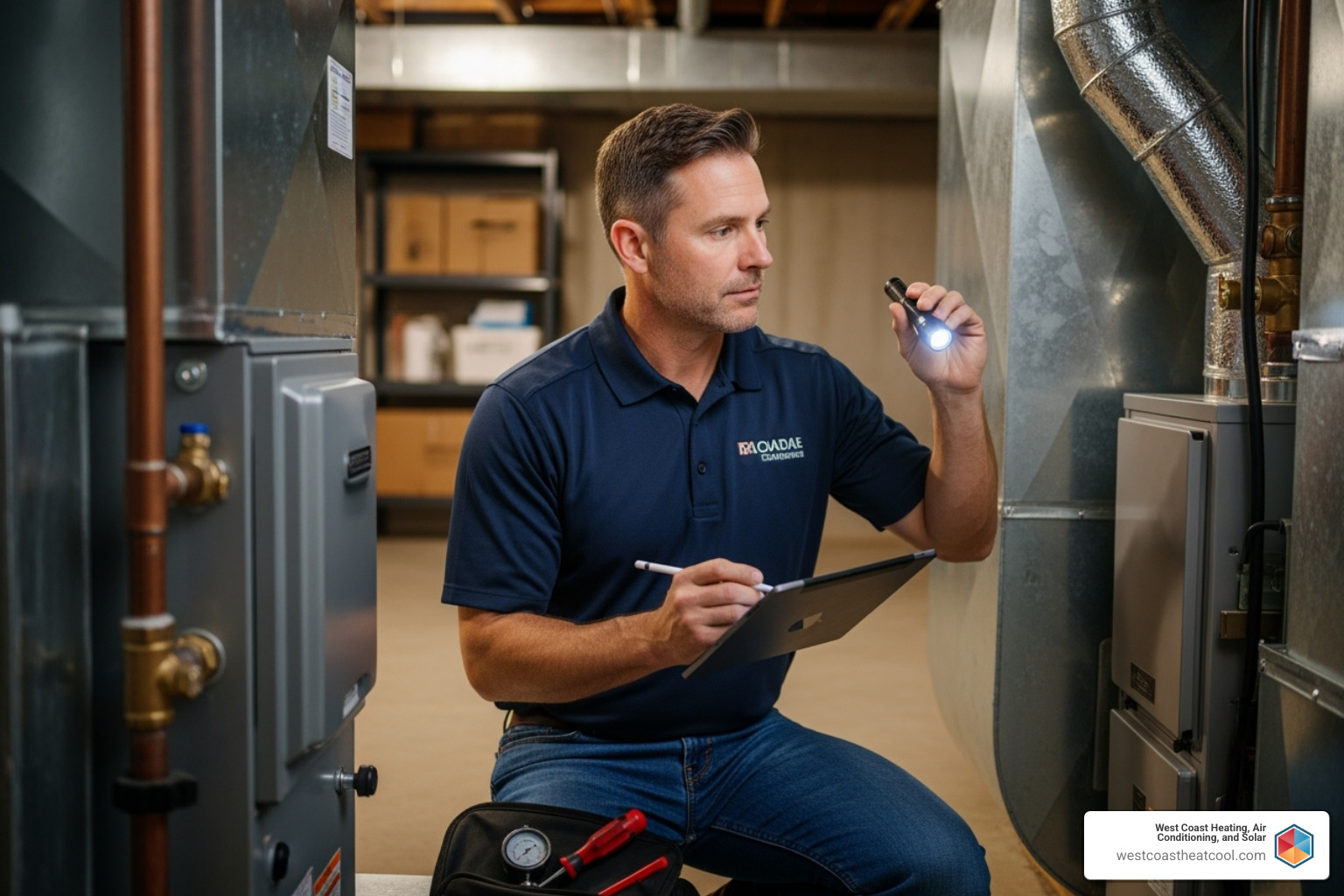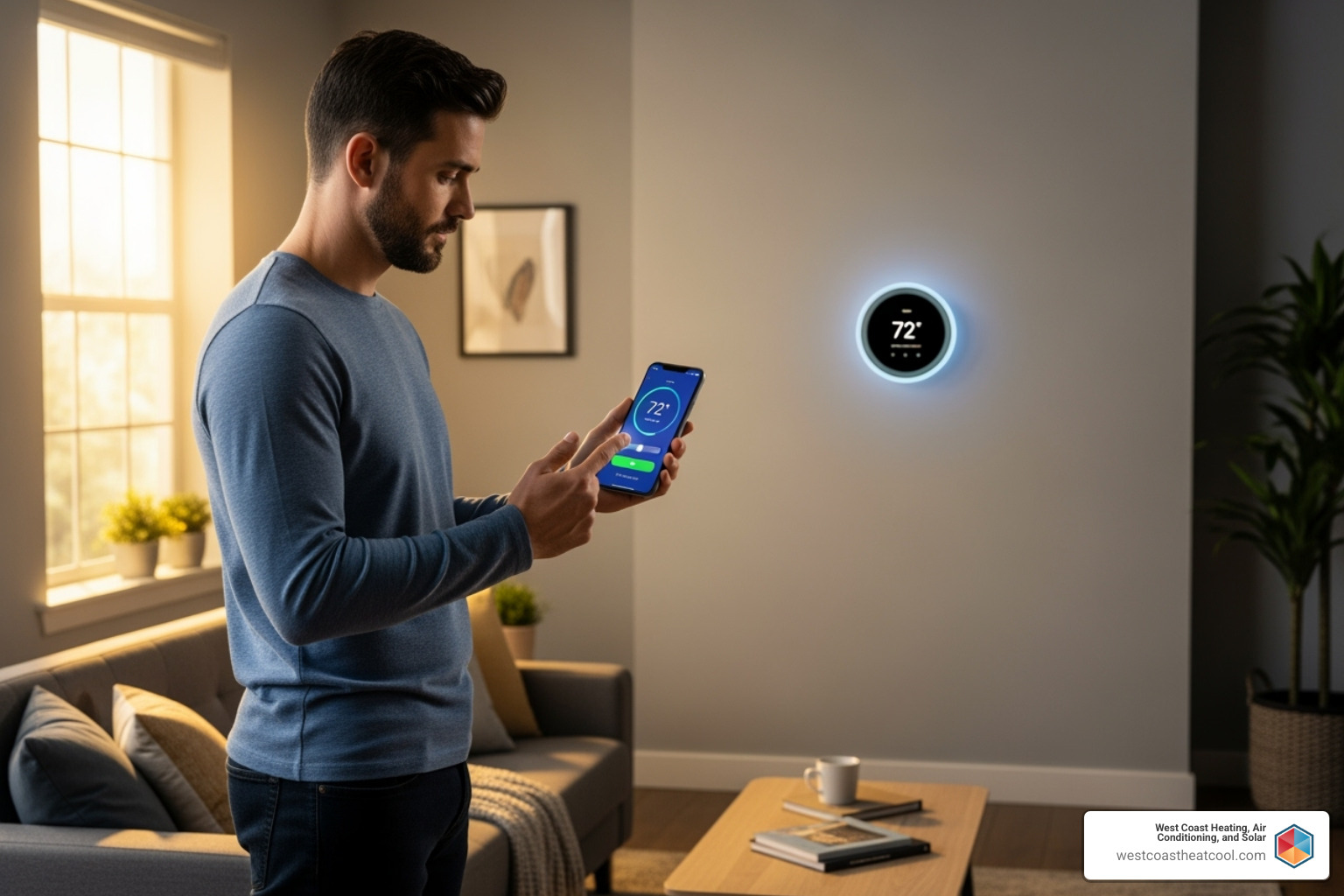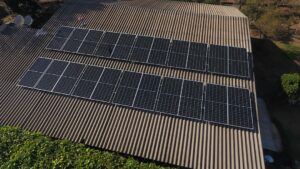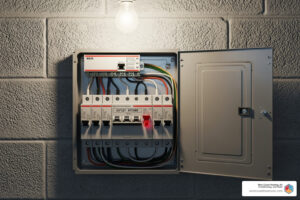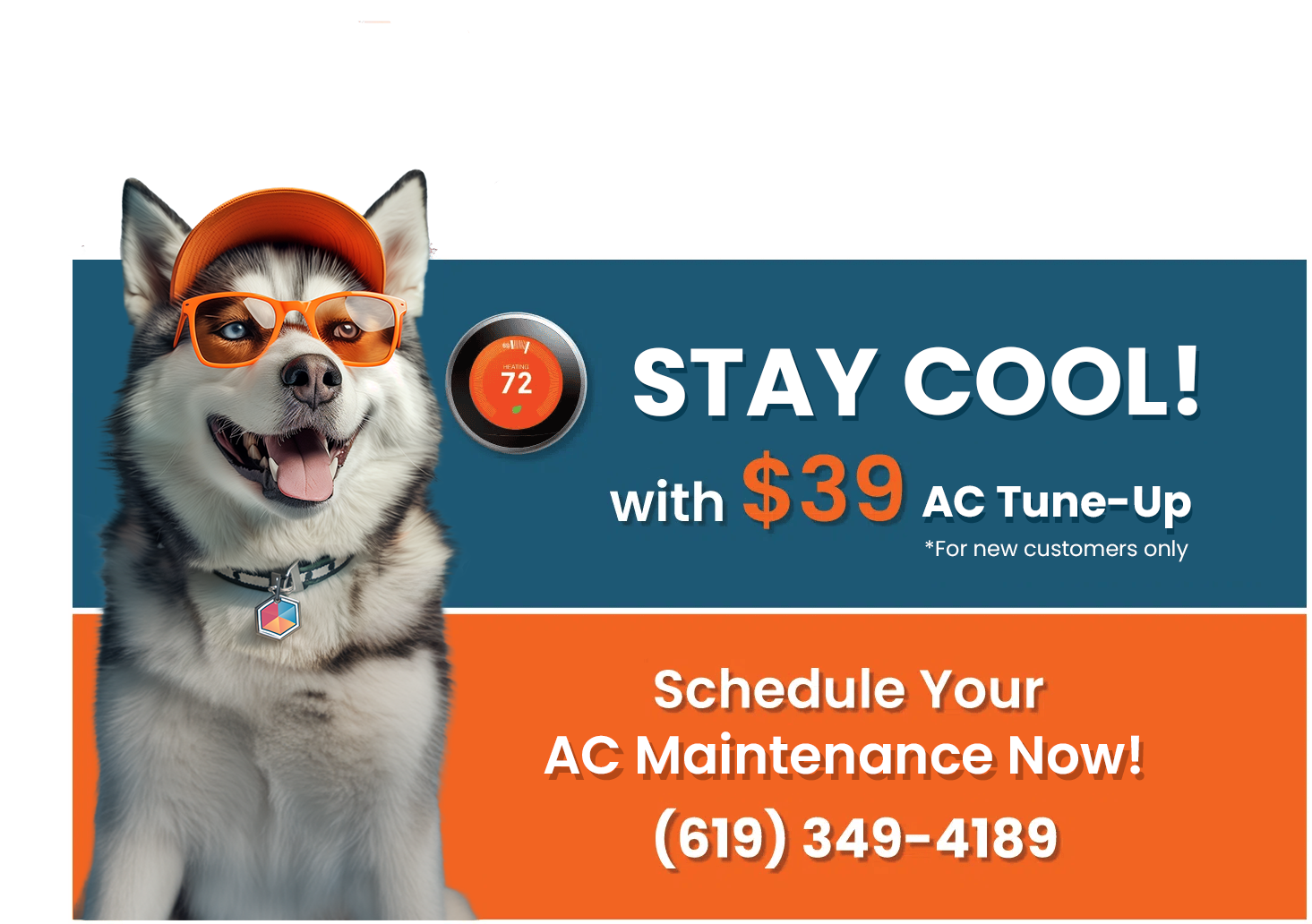Why Energy-Efficient HVAC Systems Are Game-Changers for San Diego Homes
Energy efficient HVAC systems are designed to provide maximum comfort while using minimal energy, reducing consumption by 20-50% compared to standard units. These advanced systems lead to significant benefits:
- Lower utility bills: Save hundreds of dollars annually.
- Environmental impact: Reduce your home’s carbon footprint.
- Improved comfort: Enjoy better temperature control and air quality.
- Longer lifespan: High-efficiency systems often last longer with proper maintenance.
- Increased home value: Energy-efficient upgrades are a major selling point.
In San Diego’s mild climate, where over 65% of home energy use can go to heating and cooling, the right HVAC system makes a huge difference. However, not all efficient systems are created equal. The ENERGY STAR label is a great start, but finding the perfect match requires looking at specific ratings, system types, and your home’s unique needs.
Fortunately, with federal tax credits up to $3,200 and various local rebates available, upgrading has never been more affordable.
Decoding Efficiency: Understanding the Ratings That Matter
When shopping for an energy efficient HVAC system, you’ll encounter ratings like SEER, EER, AFUE, and HSPF. These aren’t just industry jargon; they are crucial indicators of performance, much like a car’s MPG rating. A higher rating means the system converts energy into comfort more efficiently, saving you money.
In San Diego, where HVAC systems work year-round, understanding these ratings can prevent surprisingly high energy bills. The government sets minimum standards, and systems with the ENERGY STAR label exceed them, but knowing what each rating means helps you choose the perfect system for your home.
| Rating | What it Measures | What a High Number Means | Best For |
|---|---|---|---|
| SEER | Seasonal cooling efficiency over a typical season | More efficient cooling, lower energy bills | Air conditioners, Heat Pumps (cooling) |
| EER | Cooling efficiency at specific outdoor temperature | Better performance in consistently hot weather | Systems in hot, dry climates |
| AFUE | Percentage of fuel converted to usable heat | Less fuel waste, more warmth for your dollar | Gas, oil, and propane furnaces |
| HSPF | Heat pump heating efficiency over a season | More efficient heating from your heat pump | Heat Pumps (heating mode) |
What are SEER and EER Ratings?
Seasonal Energy Efficiency Ratio (SEER) is the primary rating for cooling efficiency. It measures performance over an entire cooling season, accounting for temperature fluctuations. While the minimum SEER is around 14, high-efficiency heat pumps can reach SEER ratings of 20-25 or even higher. Upgrading from a 10 SEER unit to a 20 SEER system can cut your cooling costs in half.
Energy Efficiency Ratio (EER) measures efficiency at a specific hot temperature (95°F). This is important in San Diego’s climate, as it indicates how the system performs during peak heat. Look for EER ratings of 13 or higher for optimal performance. ENERGY STAR certified systems guarantee high SEER and EER ratings, simplifying your choice. You can learn more about how these ratings work at What is SEER?
What are AFUE and HSPF Ratings?
Annual Fuel Utilization Efficiency (AFUE) measures furnace efficiency, showing the percentage of fuel converted into heat. An AFUE of 90% means 90 cents of every dollar spent on fuel becomes warmth. Modern high-efficiency furnaces boast AFUE ratings of 90% to 98%, a significant improvement over older models that might only be 60-80% efficient.
Heating Season Performance Factor (HSPF) is the heating efficiency rating for heat pumps. Since heat pumps both heat and cool, they have separate ratings for each function. A higher HSPF rating means the heat pump uses less energy to move heat from the outdoors into your home during San Diego’s cooler months, making them a great choice for year-round efficiency.
What Are the Main Types of Energy Efficient HVAC Systems?
San Diego homeowners have excellent options when it comes to energy efficient HVAC. Today’s systems are smarter and more adaptable to our year-round climate than ever before. Understanding the main types helps you choose the best fit for your home’s comfort and budget. At West Coast Heating, Air Conditioning, and Solar, we’ve helped families steer these choices since 1996. Explore our Energy Efficient HVAC Systems to see what might work for you.
High-Efficiency Heat Pumps
Heat pumps are the MVP of energy efficient HVAC, acting as both a heating and air conditioning system in one unit. Instead of creating heat, they move it. In summer, a heat pump pulls heat from inside your home and moves it outside. In winter, it reverses the process, extracting heat from the outdoor air and bringing it inside.
This heat transfer process is incredibly efficient, allowing heat pumps to achieve SEER ratings of 20 or higher. Air-source heat pumps are the most common type and are perfect for San Diego’s mild climate. Geothermal systems offer even greater efficiency by using the earth’s constant underground temperature. Learn more about this technology at How heat pumps work. Our Heat Pump Systems are designed specifically for San Diego living.
High-Efficiency Air Conditioners and Furnaces
The traditional setup of a separate air conditioner and furnace can be a great choice, especially with modern efficiency upgrades. Today’s high-efficiency central AC units can reach SEER ratings around 20, providing powerful cooling through existing ductwork while keeping energy bills low.
Modern high-efficiency furnaces are engineered for minimal waste, with AFUE ratings of 90% or higher. This means over 90 cents of every fuel dollar warms your home, a vast improvement over older systems that could waste 20-30% of their fuel. A matched high-efficiency AC and furnace pair can provide decades of reliable comfort. The Department of Energy has great information on High-efficiency furnaces.
Ductless Mini-Split Systems
Ductless mini-split systems offer customized climate control for different areas of your home. They consist of an outdoor unit connected to sleek indoor units, delivering conditioned air exactly where you need it. Their primary advantage is eliminating the ductwork energy loss that can waste 20-30% of conditioned air in traditional systems.
This makes mini-splits incredibly efficient and ideal for zoned comfort, allowing you to cool only the rooms you’re using. They are also perfect for retrofitting older homes without ductwork, home additions, or converted garages. Their quiet operation is an added bonus. See if this solution is right for you on our Ductless Mini-Split Systems page.
Choosing Your Perfect Match: Factors Beyond the Label
Choosing an energy efficient HVAC system isn’t just about picking the unit with the highest ratings. It’s about finding the perfect fit for your home, lifestyle, and the San Diego climate. Even the most efficient system will underperform if it’s not correctly matched to your home’s specific needs.
At West Coast Heating, Air Conditioning, and Solar, our customer-centric approach means we consider all these unique factors during our home assessments to ensure lasting comfort and savings. Learn more about Choosing the Right HVAC System.
Home Size, Climate, and Insulation
Proper system sizing is crucial. We use precise calculations based on your home’s square footage, layout, and ceiling height to determine the necessary capacity (BTUs). An oversized system will short cycle, wasting energy and failing to control humidity. An undersized system will run constantly without reaching the desired temperature.
San Diego’s climate is ideal for certain technologies. Our mild winters make heat pumps highly efficient, while warm summers mean high SEER ratings provide a quick return on investment. We factor in your specific microclimate, whether you’re coastal or in a warmer inland valley.
Your home’s insulation and windows are also critical. A well-insulated home holds conditioned air, reducing the workload on your HVAC system. Finally, ductwork condition is a hidden efficiency killer. Leaky ducts can lose up to 30% of your conditioned air. Properly sealed ductwork ensures that air gets where it’s supposed to go. Learn more about Sealing Ducts for Efficiency.
The Critical Role of Professional Installation and Maintenance
You can buy the best energy efficient HVAC system available, but it won’t deliver on its promises without professional installation and maintenance. These steps are essential to achieving the efficiency you paid for.
Proper installation is a technical process involving precise refrigerant charging, airflow optimization, and correct electrical connections. An error like a 10% refrigerant undercharge can reduce efficiency by 20%. Our certified technicians are trained to handle every detail, ensuring your system is engineered for optimal performance.
Regular maintenance is like a preventative checkup, catching small issues before they become expensive problems. Simple tasks like cleaning coils and changing filters can prevent a 15% loss in efficiency and extend the system’s life to 15-20 years or more. Our maintenance plans keep your system running at peak performance and your warranty valid. Find why HVAC Maintenance for Efficiency is a smart investment.
Maximizing Performance and Savings
Once you’ve invested in an energy efficient HVAC system, a few smart strategies can help you get the most out of it. Maximizing your system’s performance doesn’t require a huge budget—just some smart technology and simple habits to boost your comfort and savings.
Smart Thermostats and Zoning
A smart thermostat is one of the best upgrades for any HVAC system. Key features include:
- Programmable schedules: Automatically adjust temperatures based on your routine, so you’re not heating or cooling an empty house.
- Remote access: Control your home’s temperature from your phone, no matter where you are.
- Learning algorithms: Many units learn your preferences and fine-tune settings automatically.
- Energy reports: Understand your usage to find more opportunities to save.
Zoning systems take this a step further, creating different temperature zones within your home. This allows you to cool living areas during the day and bedrooms at night, saving energy by not conditioning unused spaces. We explore the benefits in our article, Is a Smart Thermostat Worth It?.
Simple Steps to Improve Existing System Efficiency
Even without a new system, you can boost your current unit’s performance:
- Change filters regularly: A dirty filter restricts airflow and forces your system to work harder. Check it monthly and replace it every 1-3 months.
- Keep vents clear: Ensure furniture, rugs, or drapes aren’t blocking supply and return vents.
- Seal air leaks: Use caulk or weatherstripping to seal drafts around windows and doors to keep conditioned air inside.
- Use ceiling fans: Fans create a wind-chill effect, allowing you to raise the thermostat a few degrees in summer. Reverse them in winter to push warm air down.
These simple tricks can significantly improve comfort and Improving Airflow. Additionally, closing blinds during hot afternoons and avoiding heat-producing appliances during peak hours will further reduce the load on your HVAC system.
Making Efficiency Affordable: Rebates and Tax Credits
While a high-efficiency HVAC system is a significant investment, it pays for itself over time through lower utility bills. The good news is that you don’t have to bear the full upfront cost alone. A combination of federal tax credits and local rebates can make upgrading your energy efficient HVAC system surprisingly affordable.
Federal Tax Credits
The Inflation Reduction Act of 2022 created the Energy Efficient Home Improvement Credit, a major incentive for homeowners. This provides a tax credit equal to 30% of qualified expenses for improvements made through 2032. This is a dollar-for-dollar reduction in the taxes you owe.
While most improvements are capped at $1,200 annually, heat pumps have a separate, generous limit of $2,000. This means installing a qualifying heat pump could get you a $2,000 tax credit, in addition to credits for other upgrades like windows or doors. You’ll need to file Form 5695 with your tax return. For full details, visit the IRS page on the Energy Efficient Home Improvement Credit details.
Local Rebates and Incentives
San Diego County residents can access additional savings. SDG&E often offers rebates for high-efficiency air conditioners, heat pumps, and smart thermostats. These incentives can be combined with federal credits, further reducing your out-of-pocket cost. Some homeowners save thousands by stacking utility rebates, federal credits, and manufacturer promotions.
These programs change, so it’s wise to check for current offers. The ENERGY STAR rebate finder is a great resource: Find local rebates. Our team at West Coast Heating, Air Conditioning, and Solar stays current on all available incentives and can help you maximize your savings.
Frequently Asked Questions about Energy Efficient HVAC
When considering an energy efficient HVAC system, homeowners often have similar questions. Here are answers to some of the most common ones.
How much can I really save with an energy-efficient HVAC system?
Since heating and cooling can account for over half of your home’s energy use, the savings are substantial. Most San Diego homeowners see their HVAC energy consumption drop by 20-50%. This often translates to $300-$800 in annual savings. The system typically pays for itself in 3-5 years through lower utility bills, and those savings continue for its entire 15-20 year lifespan.
How long do energy-efficient HVAC systems last?
A quality energy efficient HVAC system that is professionally installed and regularly maintained should last 15-20 years, and sometimes longer. The key is consistent care. Regular maintenance ensures the system operates at peak efficiency and helps prevent premature failures, protecting your investment for decades.
Can I pair an energy-efficient HVAC system with solar panels?
Absolutely, and it’s one of the smartest energy decisions a San Diego homeowner can make. Pairing an electric energy efficient HVAC system, like a heat pump, with solar panels allows you to power your climate control with free energy from the sun. This combination can dramatically reduce or even eliminate your electricity bill for heating and cooling.
As West Coast Heating, Air Conditioning, and Solar, we specialize in designing integrated HVAC and solar solutions. We can size both systems to work together seamlessly, maximizing your home’s efficiency and your energy independence.
Your Partner for an Efficient San Diego Home
You now have the essential information on energy efficient HVAC systems, from decoding ratings to understanding the benefits of different technologies. For modern San Diego living, energy savings, environmental responsibility, and year-round comfort are necessities, not luxuries.
At West Coast Heating, Air Conditioning, and Solar, we’ve helped San Diego families achieve this balance since 1996. We know that the right energy efficient HVAC system can cut utility bills significantly, improve comfort, and give you peace of mind.
Our customer-centric approach means we provide expert guidance custom to your home’s unique needs, whether you’re in Chula Vista, Carlsbad, or anywhere in San Diego County. We offer comprehensive solutions, from installation and financing to our club membership for year-round maintenance.
Investing in an efficient system means investing in a more comfortable home, cleaner air, and increased property value. Ready to find how much you could save with the perfect energy efficient HVAC system for your home?

